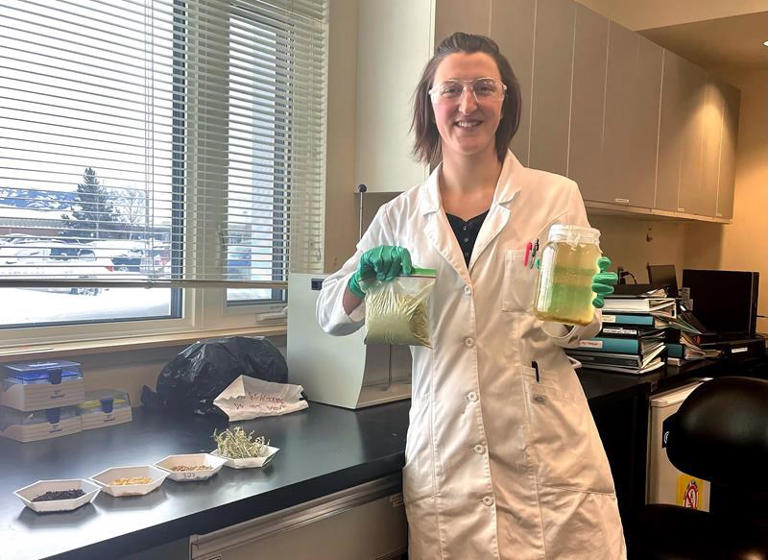2023 was the hottest year in history — and Canada is warming faster than anywhere else on earth
In 2015, most countries, including Canada, signed on to the Paris Climate Agreement which set the objective of “holding the increase in global average temperature to well below 2 C above pre-industrial levels and pursuing the limit of 1.5 C to significantly reduce the risks and impacts of climate change.”
Read more: Temperature records shattered across the world as tourists flock to experience the heat
On Jan. 9, 2024, the European Union’s Copernicus Climate Change Service (CCCS) announced that their analysis confirmed that 2023 was the hottest year on record since 1850, when humans began burning fossil fuels at a major scale. The global average temperature was 1.48 C warmer than pre-industrial levels and much warmer (0.17 C) than 2016, the previous warmest year.
The map of surface air temperature anomalies around the globe, compared to the 1991–2020 average, shows large geographical variations and that some of the warmest areas are in Canada.
Rising temperatures
Leading scientists are predicting that 2024 will be even warmer as the global mean temperature continues to rise.
These rising temperatures are leading to more extreme weather events that impact societies around the world and across Canada. The atmospheric concentrations of carbon dioxide and methane have continued to increase and reached record levels in 2023, reaching 419 parts-per-million (ppm) of carbon dioxide concentrations, which was 2.4 ppm higher than in 2022.
Read more: How 2023's record heat worsened droughts, floods and bushfires around the world
The CCCS also noted that, in 2023, many extreme events were recorded across the globe, including heat waves, floods, droughts and wildfires.
On Jan. 10, the World Economic Forum published its 2024 Global Risks Report, ranking global risks by severity over the next ten years. Extreme weather events are ranked to be the highest risk, leading to loss of human life, damage to ecosystems, destruction of property and/or financial loss.
Canada’s unique climate
Climate warming is not uniform due to a range of factors, including internal climate variability and regional variations in climate feedback and heat uptake.
In general, warming has been strongest at high northern latitudes and stronger over land than oceans. Global average temperature is greatly influenced by the oceans, which cover about 70 per cent of the planet and have large heat capacity, so they warm much slower than land areas.
Since Canada has a large land mass, much of which is located at high northern latitudes, warming across Canada has been about twice the global average and in the Canadian Arctic, the warming has been about three times higher. Loss of snow and sea ice reduces the reflectivity of the surface, resulting in stronger warming of ecosystems and increased absorption of solar radiation.
Read more: How Canadian courts are taking on climate change
Surface temperatures are highly linked to the temperatures in the troposphere, which is the lowest layer of Earth’s atmosphere.
The troposphere includes most of the clouds and weather and varies from 18–20 kilometres in depth at the equator to about six kilometres near the poles. This smaller depth in the Arctic can result in more warming due to the heat energy from solar radiation or other processes.
Feedback processes
Enhanced warming for Canada as a whole, and for the Canadian Arctic in particular, is part of a climate phenomenon known as “Arctic amplification.” The climate response to radiative forcing from greenhouse gases is determined by subsequent processes and feedback within the climate system. Climate feedback in the Arctic enhance the warming from greenhouse gas forcing.
A figure showing historical observations of annual mean surface temperature with Canada and the Canadian Arctic well above the global average.© (Environment Canada Climate Research Division)
Feedback mechanisms make different contributions to warming, depending on the region of the world. Snow and ice reflect considerable solar energy back to space. When warming melts snow and ice, this causes the now-darker surface to absorb more solar radiation and heat.
Another issue is that atmospheric components radiate energy back to space, cooling the climate somewhat, but in the Arctic, this cooling effect is weaker and there is a relatively larger warming response at higher latitudes. Another factor is that in the Arctic, the increase in clouds enhances warming by trapping heat near the surface.
Urgent action is needed
The enhanced rates of warming over Canada and the Canadian Arctic are due to a unique combination of feedback mechanisms.
The year 2023 demonstrated the devastating impacts of the climate extremes that can and will occur in even the best case 1.5 C climate scenario hoped for by the Paris Agreement.
Canada, and particularly our north, will warm much faster than the global mean. This reality should have the effect of motivating governments at all levels — and citizens — to reduce the historic complacency displayed by most governments around the world.
The time is overdue to take comprehensive and strong actions to reduce greenhouse gas emissions and to fully implement adaptation actions to make our societies and citizens less vulnerable and more resilient.
Through enabling communities across Canada to proactively advance climate resilience we can effectively reduce the risk of adverse climate impacts and prevent losses and damages during the extremes that a warming climate will bring.
This article is republished from The Conversation, >, a nonprofit, independent news organization bringing you facts and analysis to help you make sense of our complex world.
Read more:
Gordon McBean does not work for, consult, own shares in or receive funding from any company or organisation that would benefit from this article, and has disclosed no relevant affiliations beyond their academic appointment.








 \
\


